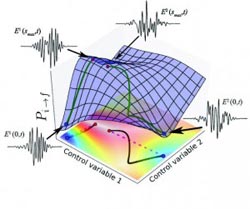When scaling the quantum slopes, veer for the straight path

Princeton University researchers found that the “landscape” for quantum control (above) — a representation of quantum mechanics that allows the dynamics of atoms and molecules to be manipulated — can be unexpectedly simple, which could help scientists realize the next generation of technology by harnessing atoms and molecules to create small but incredibly powerful devices. Scientists achieve quantum control by finding the ideal radiation field (top of the graphic) that leads to the desired response from the system. Like a mountain hiker, a scientist can take a difficult, twisting path that requires frequent stops to evaluate the next step (right path). Or, they can opt for a straighter trail that cuts directly to the summit (left path). The researchers provide in their paper an algorithm that scientists can use to identify the starting point of the straight path to their desired quantum field. (Image courtesy of Arun Nanduri)<br>
More efficient methods for manipulating quantum systems could help scientists realize the next generation of technology by harnessing atoms and molecules to create small but incredibly powerful devices such as molecular electronics or quantum computers.
Of course, controlling quantum systems is as painstaking as it sounds, and requires scientists to discover the ideal radiation field that leads to the desired response from the system. Scientists know that reaching that state of quantum nirvana can be a long and expensive slog, but Princeton University researchers have found that the process might be more straightforward than previously thought.
The researchers report in the journal Physical Review A that quantum-control “landscapes” — the path of a system’s response from the initial field to the final desired field — appears to be unexpectedly simple. Although still a mountain of a task, finding a good control radiation field turns out to be very much like climbing a mountain, and scientists need only choose the right path. Like a hiker, a scientist can take a difficult, twisting path that requires frequent stops to evaluate which step to take next. Or, as the Princeton researchers show, they can opt for a straighter trail that cuts directly to the summit.
The researchers observe in their paper that these fast tracks toward the desired control field actually exist, and are scattered all over the landscape. They provide an algorithm that scientists can use to identify the starting point of the straight path to their desired quantum field.
The existence of nearly straight paths to reach the best quantum control was surprising because the landscapes were assumed to be serpentine, explained first author Arun Nanduri, who received his bachelor’s degree in physics from Princeton in 2013 and is working in the laboratory of Herschel Rabitz, Princeton’s Charles Phelps Smyth ’16 *17 Professor of Chemistry.
“We found that not only can you always climb to the top, but you can climb along a simple path to the top,” Nanduri said. “If we could consistently identify where these paths are located, a scientist could efficiently climb the landscape. Looking around for the next good step along an unknown path takes great effort. However, starting along a straight path requires you to look around once, and you can keep walking forward with your eyes closed, as it were.”
Following a straighter path could be a far more efficient way of achieving control of atoms and molecules for a host of applications, including manipulating chemical reactions and operating quantum computers, Nanduri said. The source of much scientific excitement, quantum computers would use “qubits” that can be entangled to potentially give them enormous storage and computational capacities far beyond the capabilities of today’s digital computers.
If the Princeton research helps scientists quickly and easily find the control fields they need, it could also allow them to carry out improved measurements of quantum systems and design new ones, Nanduri said.
“We don’t know if our discovery will directly lead to futuristic quantum devices, but this finding should spur renewed research,” Nanduri said. “If straight paths to good quantum control solutions can be routinely found, it would be remarkable.”
Nanduri, Arun, Ashley Donovan, Tak-San Ho, Herschel Rabitz. 2013. Exploring quantum control landscape structure. Physical Review A. Article published: Sept. 30, 2013. DOI: 10.1103/PhysRevA.88.033425
The work was funded by the Program in Plasma Science and Technology at Princeton University, the Army Research Office, and the U.S. Department of Energy.
Media Contact
More Information:
http://www.princeton.eduAll latest news from the category: Physics and Astronomy
This area deals with the fundamental laws and building blocks of nature and how they interact, the properties and the behavior of matter, and research into space and time and their structures.
innovations-report provides in-depth reports and articles on subjects such as astrophysics, laser technologies, nuclear, quantum, particle and solid-state physics, nanotechnologies, planetary research and findings (Mars, Venus) and developments related to the Hubble Telescope.
Newest articles

Properties of new materials for microchips
… can now be measured well. Reseachers of Delft University of Technology demonstrated measuring performance properties of ultrathin silicon membranes. Making ever smaller and more powerful chips requires new ultrathin…

Floating solar’s potential
… to support sustainable development by addressing climate, water, and energy goals holistically. A new study published this week in Nature Energy raises the potential for floating solar photovoltaics (FPV)…

Skyrmions move at record speeds
… a step towards the computing of the future. An international research team led by scientists from the CNRS1 has discovered that the magnetic nanobubbles2 known as skyrmions can be…





















